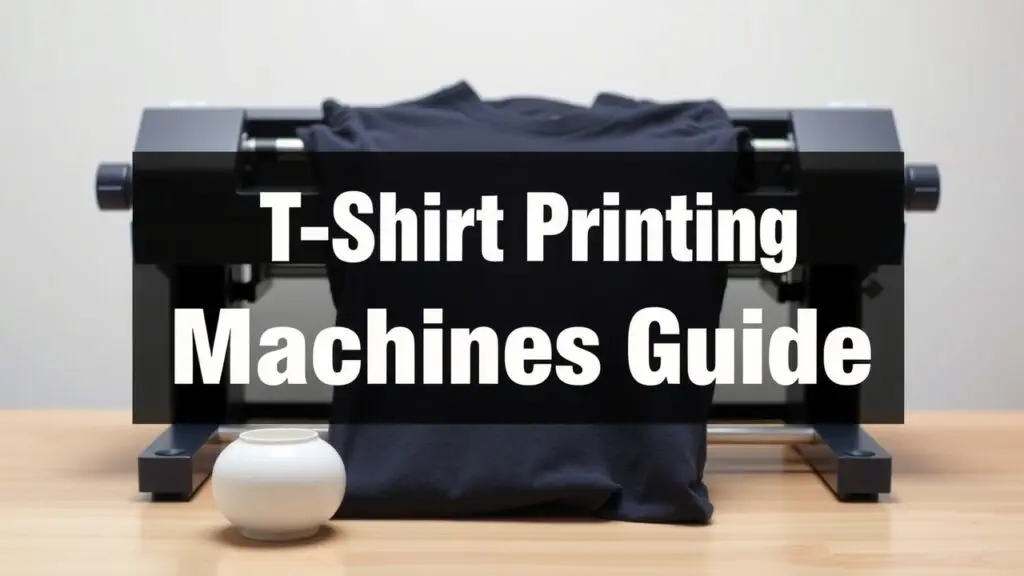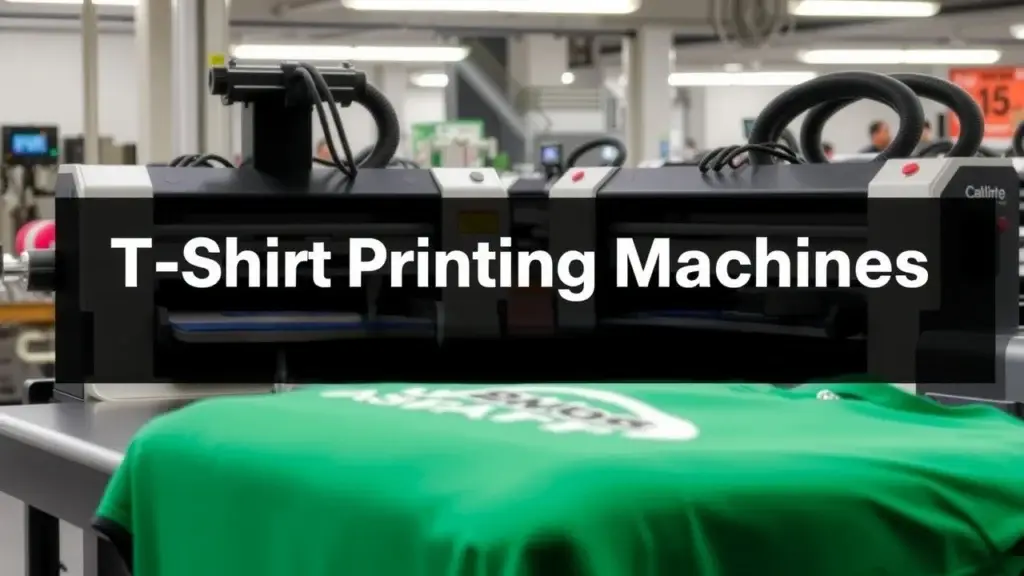This guide explores various t-shirt printing machines, including screen printing, direct-to-garment (DTG), and others. Learn which machine best suits your budget, quality needs, and volume.
What Are T-Shirt Printing Machines?

T-shirt printing machines are tools that help create custom designs on fabrics, especially t-shirts. There are different types of t-shirt printing machines, and each one is made for specific printing styles and business needs. Here are some common types:
- Screen Printing Machines: This method uses a stencil or screen for every color in the design. Ink gets pushed through the screens onto the fabric. Screen printing is tough and has bright colors, but it takes more time to set up.
- Direct-to-Garment (DTG) Printers: DTG printers use inkjet technology to print directly onto clothes. They work well for complex designs with many colors. However, they might be slower compared to other methods.
- Heat Transfer Presses: These machines use heat to transfer designs from special paper onto fabrics. They’re easy to use and perfect for small runs or unique items, though they may not last as long as other methods.
- Sublimation Printers: Sublimation works by turning solid dye into gas using heat. The dye then gets into the fabric fibers, creating bright prints that don’t crack or fade easily—this method works best on polyester materials.
- Vinyl Cutters: This process cuts shapes from colored vinyl sheets, which are then stuck onto shirts using a heat press. Vinyl cutting is great for simple graphics or text.
Every machine has its own features designed for specific uses in custom apparel production.
Why Choosing the Right Machine Matters for Your Business Needs?
Picking the right t-shirt printing machine is really important because it affects how fast you can produce items, how good the quality is, and how much money you can make:
- Budget Considerations: Different machines have different prices. Think about not just the purchase price but also costs like supplies and maintenance.
- Order Volume Requirements: If you need to make a lot of shirts often, an automatic screen printer might be better than a manual one or a DTG printer.
- Design Complexity: For detailed designs with many colors, DTG printers work well. But for simpler graphics, vinyl cutters are a better fit.
- Print Quality Expectations: Different machines produce varying detail levels; knowing what quality you need will help you choose the right one.
- Fabric Compatibility: Not all machines do well with every fabric type; understanding your primary materials will help narrow down choices.
Making a smart choice ensures your investment meets both current needs and future growth in your custom apparel business.
Types of T-Shirt Printing Machines Explained
Screen Printing Machines for Apparel Businesses
Screen printing is a popular method for making custom clothes. It uses a stencil to apply ink to fabric. This method creates bright colors and strong prints, making it perfect for large orders.
How Does Screen Printing Work?
In screen printing, each color in a design needs its own screen. A mesh screen is covered with a special material that hardens when light hits it. After exposure, areas not covered by the design are washed away, leaving behind a stencil. Ink is pushed through the stencil onto the shirt using a tool called a squeegee, resulting in high-quality prints.
Advantages & Disadvantages of Screen Printing
Screen printing has many benefits. One key advantage is durability; prints can last through many washes without fading. It’s also cost-effective for big orders because setup costs are spread across many items. However, some downsides include high initial costs due to equipment and materials, and it can be less flexible for detailed designs or small runs since each color needs its own screen.
Types of Screen Printing Equipment
There are different types of equipment for screen printing:
- Manual Presses: Good for beginners or small businesses; they need more hands-on work but cost less upfront.
- Automatic Presses: Great for high-volume production because they speed up the process.
- Carousel Presses: These let you create multi-color designs quickly by rotating screens into place.
Direct-to-Garment Printers (DTG)
Direct-to-garment printers are another modern way to print t-shirts. They use inkjet technology to print directly on garments without stencils or transfer papers.
What Is DTG Technology?
DTG printers work like regular inkjet printers but are made specifically for clothing. They spray water-based inks directly onto fabric using special nozzles. This ensures accurate application and bright colors on different fabrics.
Benefits & Drawbacks of DTG Printers
The main benefit of DTG printing is its ability to create photo-like images quickly, which is great for detailed artwork or small runs without needing much setup time. On the downside, these printers are usually slower than traditional methods like screen printing when working with larger quantities.
Heat Transfer Machines Overview
Heat transfer machines use heat press techniques to put printed designs from paper or vinyl onto fabric.
How Heat Transfer Works on Fabrics?
This method moves an image from special transfer paper or vinyl sheets onto clothing using heat press machines that apply pressure and heat together. This helps bond the layers together, creating lasting designs on garments.
Types Within Heat Transfer Methods
Different systems exist in heat transfer technology:
- Vinyl Cutting Systems: Cut shapes from colored vinyl that can then be pressed onto shirts.
- Direct-to-Film Printers (DTF): Print graphics straight onto film before using heat to apply them.
- Inkjet Transfers: Use regular inkjet printers with specific transfer papers designed just for fabrics, allowing flexibility across various projects.
Advantages vs Limitations in Practice
Heat presses are often affordable and easy to use, making them attractive choices for beginners entering custom apparel markets! Despite their pros, like quick turnaround times, they might produce prints that don’t last as long as those made with other methods over time. This could make potential customers look for longer-lasting options elsewhere!
Sublimation Printing: A Deep Dive
Sublimation printing is a great way to create vibrant, custom apparel. This method uses heat to transfer dye onto materials, mostly polyester fabrics. It allows for all-over printing and produces bright colors that last a long time without fading.
How Sublimation Printing Works?
The sublimation process has several important steps. First, you print a design onto special sublimation paper with sublimation ink. When heated, this ink turns into gas and bonds with the fabric fibers during the heat press application. Heat press machines are crucial in this process because they apply both heat and pressure to ensure the dye transfers correctly.
Print quality in sublimation printing is usually high. The dyes penetrate the fabric instead of sitting on top like other methods. However, this technique works best with synthetic materials like polyester t-shirts because natural fabrics don’t hold the dye well.
Pros & Cons of Sublimation
Advantages of Sublimation Printing:
- Vibrant Prints: The colors produced are vivid and can cover large areas without losing quality.
- Long-lasting Results: Since the dyes become part of the fabric, prints resist cracking or peeling over time.
- Versatility: Great for all-over designs and complex images needing detailed color gradients.
Limitations of Sublimation Printing:
- Fabric Restrictions: It only works well on polyester or polymer-coated materials; cotton shirts can’t be used effectively.
- Initial Setup Costs: While running costs may be low, starting up can be expensive due to printers and equipment costs.
Knowing these pros and cons helps small business owners decide if sublimation printing fits their custom apparel production goals.
Types of Sublimation Printers & Considerations
There are several types of sublimation printers to choose from:
- Desktop Printers: Good for small-scale operations or beginners starting a custom apparel business at home.
- Industrial Printers: Built for larger businesses that need higher output volumes; they often come with advanced features but cost more.
- Commercial T-Shirt Printers: These machines balance cost-effectiveness with print quality, making them suitable for medium-sized companies focusing on bulk orders.
When picking a printer, consider factors like print speed, resolution capabilities, maintenance needs, and overall cost. Each type offers benefits suited to different scales of operation in t-shirt printing.
Vinyl Printing and Cutting: A Detailed Guide
Vinyl printing is a fun way to create custom designs on clothes, especially t-shirts. This method uses heat transfer vinyl (HTV) to stick graphics onto fabric. First, you cut your design from a sheet of vinyl using a vinyl cutter. After cutting, you remove the extra material around your design. Then, you place the vinyl on the garment and use a heat press machine to apply heat. This helps the vinyl stick well to the fabric.
How Vinyl Printing Works?
The vinyl printing process starts with choosing good-quality HTV that comes in different colors and textures. You design your graphic using software that works with your cutter. Once you’re happy with your design, send it to the cutter. The cutter will carefully slice through the top layer of vinyl while keeping its backing intact.
After cutting, you’ll need to weed out any unwanted bits of vinyl around your design. Next, put your cleaned-up design onto the shirt or garment where you want it shown off. Using a heat press machine is great because it applies even pressure and heat when you’re making the print. This results in durable prints that last through many washes.
Pros & Cons of Vinyl Printing
Vinyl printing has some great benefits:
- Durable Prints: HTV designs last a long time if applied correctly.
- Cost-Effectiveness for Small Orders: It’s cheaper for small orders since you don’t have extra setup costs like in screen printing.
But there are some downsides too:
- Design Limitations: Very detailed designs can be tricky because this method can’t capture as much detail as others like direct-to-garment (DTG) printing.
Types of Vinyl Cutters
There are several types of vinyl cutters on the market today:
- Manual Cutters: These need more hands-on work but are usually cheaper.
- Electronic Cutters: They automate much of the cutting process and often come with handy features like Bluetooth.
- Plotter Cutters: Made for bigger projects or commercial use; they cut faster and more precisely.
When picking a cutter, think about things like what materials it can cut and if it works well with your software. This choice will help fit it into how you work best.
Understanding how these machines work can help you make smart choices about starting your custom apparel business while staying within budget and matching your skills in garment decoration.
Exploring Other T-Shirt Printing Techniques
Embroidery as a T-Shirt Printing Method
Embroidery adds unique designs to t-shirts. It uses threads to stitch patterns on the fabric. This method gives a detailed and textured look. One big plus is its durability; embroidered designs can handle lots of washing without fading or peeling.
Embroidery machines vary in type. Some are for small projects, while others can tackle larger orders quickly. Although starting with an embroidery machine might cost more than other methods, the long-lasting quality makes it worth it for many businesses.
Discharge Printing Technique
Discharge printing is different from regular printing. Here, special inks remove color from the fabric instead of adding it. This technique works best on dark shirts because it makes the print feel soft, almost like it’s part of the shirt.
A major benefit of discharge printing is that it’s eco-friendly. Many inks used in this process are water-based and don’t have harmful chemicals found in regular inks. This makes it a great choice for brands that care about the environment while producing custom t-shirts.
Flocking Process Overview
Flocking gives t-shirts a cool velvety texture. This technique uses tiny fibers stuck onto the fabric to create a rich feel and vibrant colors. The prints made this way are durable, too, making them ideal for clothing lines that want to stand out.
Though flocking requires special tools, it opens up fun design options that regular screen printing can’t do as well. It’s perfect for promotional items or limited editions where eye-catching looks are key.
Comparison of Alternative Methods with Traditional Techniques
When you stack up newer t-shirt printing methods like embroidery, discharge printing, and flocking against classic techniques like screen printing and direct-to-garment (DTG) printing, there are some key points to think about:
| Method Type | Cost Effectiveness | Design Limitations | Print Quality & Durability |
|---|---|---|---|
| Screen Printing | Low setup costs | Best for simple designs | Very durable |
| DTG | Higher per-item cost | Complex full-color graphics | Excellent quality |
| Embroidery | Moderate initial cost | Limited by thread colors | Very durable |
| Discharge Printing | Moderate setup costs | Best on specific fabrics | Soft feel |
| Flocking | Higher material costs | Limited color options | Unique texture |
Each method has its strong points depending on what your business needs—like if you want low-cost production or high-quality finishes. Knowing these differences can help you pick the right approach for your t-shirt printing projects!
Factors to Consider When Choosing a T-Shirt Printing Machine

Choosing a t-shirt printing machine is really important for people starting a business or trying to grow one. There are several things to think about, like your budget, how many shirts you’ll print, how complex the designs are, what fabrics you’ll use, your skill level, and how much space you have.
Budget
When thinking about a t-shirt printing machine, the cost is usually the first thing on people’s minds. The price can vary a lot depending on what type of machine you want. Here’s a quick breakdown:
- Screen Printing Machines: These can cost anywhere from $200 for simple manual ones to over $10,000 for automatic models.
- Direct-to-Garment (DTG) Printers: They usually start around $5,000 but can go up to $20,000 with more features.
- Heat Press Machines: You can find affordable options starting at about $300, but they might not do everything you need.
Don’t forget about ongoing costs too! This includes ink and materials. Affordable t-shirt printing machines might seem like a good deal at first but could be pricey to run later.
Order Volume
How many shirts you plan to print is a big factor in picking your printer.
- Low-volume T-Shirt Printing Machines: These are perfect for new businesses or custom orders that need less than 50 shirts at a time.
- High-volume T-Shirt Printing Machines: If you expect to print many shirts regularly, these are the way to go. They help with production efficiency in your garment business.
Knowing how many shirts you’ll make helps in choosing the right machine without wasting money.
Design Complexity
The types of designs you’ll create affect your choice too. Here’s what you should know:
- Screen Printing is great for bold colors and simple designs. But it may not handle intricate details well unless you’re using advanced methods.
- DTG Printers shine when it comes to complex images. They print directly onto garments like regular inkjet printers do.
Think about the custom apparel designs you want to create when picking out your printing machine.
Fabric Compatibility
Not all fabrics work well with every printing method:
- Screen printers are best on cotton fabrics since they soak up inks easily.
- DTG printers also prefer cotton but can work with some blends too.
- Sublimation is best for polyester because it bonds dye with synthetic fibers during heat application.
Knowing what fabrics fit with your printing method saves time and trouble later on!
Technical Skills
Before buying, think about the skills needed for different printers:
Some printers are made for beginners. They come with easy-to-follow guides or user-friendly software. But more advanced equipment might require special training or experience with graphic design tools like Adobe Illustrator.
If you’re new to screen printing technology, try learning through online courses or local workshops from suppliers who sell those machines!
Space Requirements
Don’t forget about space! This part is sometimes overlooked.
Industrial printers usually need a lot of room and proper ventilation due to fumes. On the other hand, smaller-scale printers fit easily in homes. This makes them great for hobbyists who don’t want their living space taken up!
By looking at all these factors—from budget limits to space needs—you can make better choices when picking high-quality t-shirt printing machines that suit your unique goals!
Recommendations Based on Business Needs
Picking the right machine depends mostly on your business size and needs:
For Startups
If you are just starting out in the custom apparel market, you might want to look at budget-friendly options like manual screen presses or basic DTG printers. They are affordable and help you try things out without spending too much money.
For Medium-Sized Businesses
When your business grows, consider versatile models like automatic screen presses or mid-range DTG units. These machines give you a good mix of price and quality. They’re great for bigger orders but still easy enough to operate for someone with some experience.
For Large-Scale Operations
If you’re all about high-volume production, you will need industrial-grade machines. Advanced automatic systems can churn out lots of products fast. Dedicated sublimation setups also provide great quality prints for certain fabric types.
Maintenance and Troubleshooting Tips
Taking care of your t-shirt printing machine helps it last longer and work better:
- Clean all parts regularly according to the instructions.
- Check ink levels often if you’re using an ink-based system like DTG.
- Inspect heating elements in heat presses; replace them if they look worn out.
Some common problems include clogged nozzles in DTG printers or misalignment in vinyl cutters. These issues need quick fixes to prevent costly repairs later on.
Maintenance costs depend on how much you use the machine. It’s smart to budget about 10% of your initial investment each year for upkeep expenses.
FAQs about T-Shirt Printing Machines
What are the best t-shirt printing machines for beginners?
Beginners should consider heat press machines or manual screen printers. These options are cost-effective and easy to use.
How do I choose the right t-shirt printing machine?
Assess your budget, expected order volume, and design complexity. Consider the fabric types you plan to use as well.
What is the cost of a t-shirt printing machine?
Prices range widely based on type. Manual machines can start at $200, while advanced DTG printers may exceed $20,000.
Are there all-in-one t-shirt printing machines available?
Yes, some machines combine various functions like screen printing and heat transfer in one unit for versatility.
What types of inks are used in t-shirt printing?
Common inks include plastisol, water-based, discharge ink, and sublimation ink. Each has its unique applications and benefits.
How do industrial t-shirt printing machines differ from small-scale ones?
Industrial machines handle high-volume production efficiently while small-scale printers focus on customization and smaller batches.
What maintenance does a t-shirt printing machine require?
Regular cleaning is essential. You should check ink levels and ensure heating elements function correctly to avoid breakdowns.
Types of T-Shirt Printing Techniques
- Screen Printing: Cost-effective for large orders.
- DTG Printing: Ideal for complex designs.
- Sublimation: Best for vibrant prints on polyester.
- Heat Transfer: Versatile but less durable.
- Vinyl Printing: Great for simple graphics and small runs.
Choosing Between Different T-Shirt Printing Methods
- Manual vs Automatic: Manual is better for low volume; automatic suits high production needs.
- Fabric Compatibility: Ensure the chosen method works with your fabric type.
- Design Flexibility: Some methods handle intricate designs better than others.
Understanding T-Shirt Printing Equipment
- Essential Supplies: Include inks, transfer papers, and vinyl.
- Accessories Needed: Heat presses, vinyl cutters, and pretreatment solutions enhance functionality.
- Repair Parts Availability: Regular parts replacement ensures consistent performance.
Exploring T-Shirt Printing Business Opportunities
- Customization Options: Offer personalized apparel through various methods.
- Eco-Friendly Choices: Use sustainable inks and materials to attract environmentally conscious customers.
- Bulk vs On-Demand Printing: Choose a model that fits your target market’s needs effectively.
Related Topics
- Types of screen printing equipment
- Types of heat transfer methods
- Types of sublimation printers
- Types of embroidery machines
- Types of inks used in t-shirt printing
- Types of t-shirt printing techniques



Types of T-Shirt Printing Machines: Screen Printing, DTG, & More